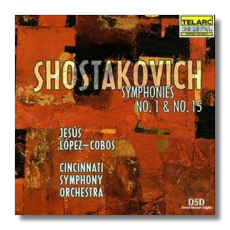
The Internet's Premier Classical Music Source
Related Links
- Shostakovich Reviews
- Latest Reviews
- More Reviews
-
By Composer
-
Collections
DVD & Blu-ray
Books
Concert Reviews
Articles/Interviews
Software
Audio
Search Amazon
Recommended Links
Site News
 CD Review
CD Review
Dmitri Shostakovich

Symphonies
- Symphony #1 in F minor, Op. 10 (1925)
- Symphony #15 in A Major, Op. 141 (1971)
Cincinnati Symphony Orchestra/Jesús López-Cobos
Telarc CD-80572 DDD 76:54
The first and last symphonies of Dmitri Shostakovich make very acceptable discmates, even though more than 45 years separate them. It would be wrong to describe the First Symphony as the work of teenager as yet untouched by adversity. Post-Revolutionary Russia hardly was affluent, and the composer's home life was negatively impacted by the death of his father in 1922 and by a serious case of tuberculosis one year later. There's youthfulness in the symphony, and a youth's desire to impress and to shock, but there's also a deep bitterness – more than just sarcasm – unusual in someone so young.
The Fifteenth Symphony was composed by a physically ill man who felt that the time for summing-up had come. Quotations from earlier symphonies – and from the music of Rossini, Wagner, and Glinka – give new meaning to the expression "my life flashed before my eyes." The opening movement, supposedly a depiction of childhood or a toy store, is tender enough, but the repeated allusions to the final section of Rossini's William Tell Overture are snide and sour. Dark colors dominate the rest of the symphony. The third movement, a scherzo of sorts, is nevertheless a danse macabre performed in a blackened auditorium to an audience already dead. From time to time, ticking and tocking intrusions by the percussion hint that the clock is running. However, when the symphony comes to a close with the same dry-as-bones mechanism clattering away, Shostakovich magically transforms it into if not comfort, then at least into a wry, smiling parody of John Donne's "Ask not for whom the bell tolls…."
With this CD, López-Cobos shows that he an accomplished interpreter of Shostakovich's music. The First Symphony is not difficult to bring off, and so the conductor takes a relaxed approach, neither rushing, biting, nor grabbing at specious interpretive points. On the other hand, the Cincinnati Symphony Orchestra doesn't always have the sound required to make the climaxes blossom, and there is some stiffness from the brass. The Fifteenth Symphony could hardly be better, though; here is a recording to stand with Ormandy's. (This was reissued not too long ago in RCA Victor's High Performance series.) López-Cobos and the Cincinnatians play the Fifteenth as chamber music, and here the orchestra's solo players show the good stuff that they are made of. Apart from a few loud climaxes, this is a quiet score, and López-Cobos does a superb job of regulating dynamic levels: no boring, all-purpose pianos and pianissimos here. A high level of concentration is maintained throughout. In a score that can become rambling and disconnected, López-Cobos and his orchestra remain cognizant of the big picture.
Telarc's "Direct Stream Digital" engineering blesses the quiet music as well as the loud. The label claims a dynamic range of greater than 120 dB (and a frequency response from 0 to beyond 100 kHz), and I can well believe it. No gimmickry here, however, just masterful music masterfully played and honestly recorded.
Copyright © 2001, Raymond Tuttle




















